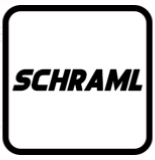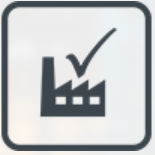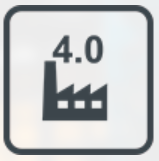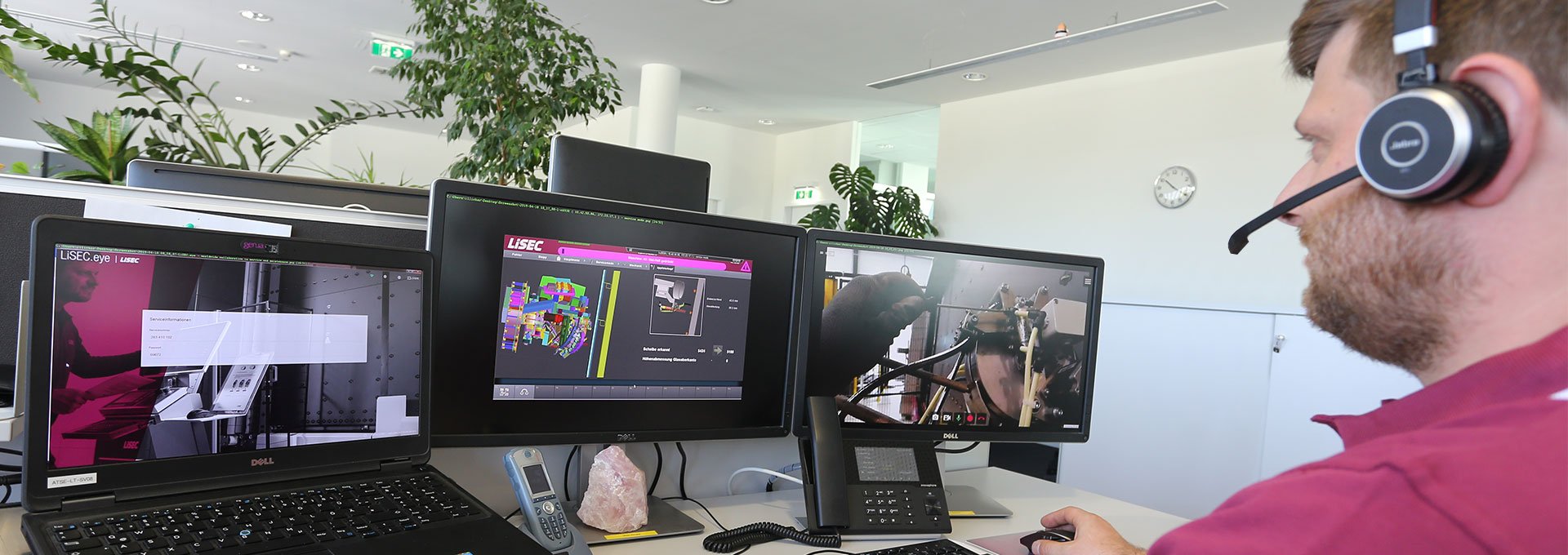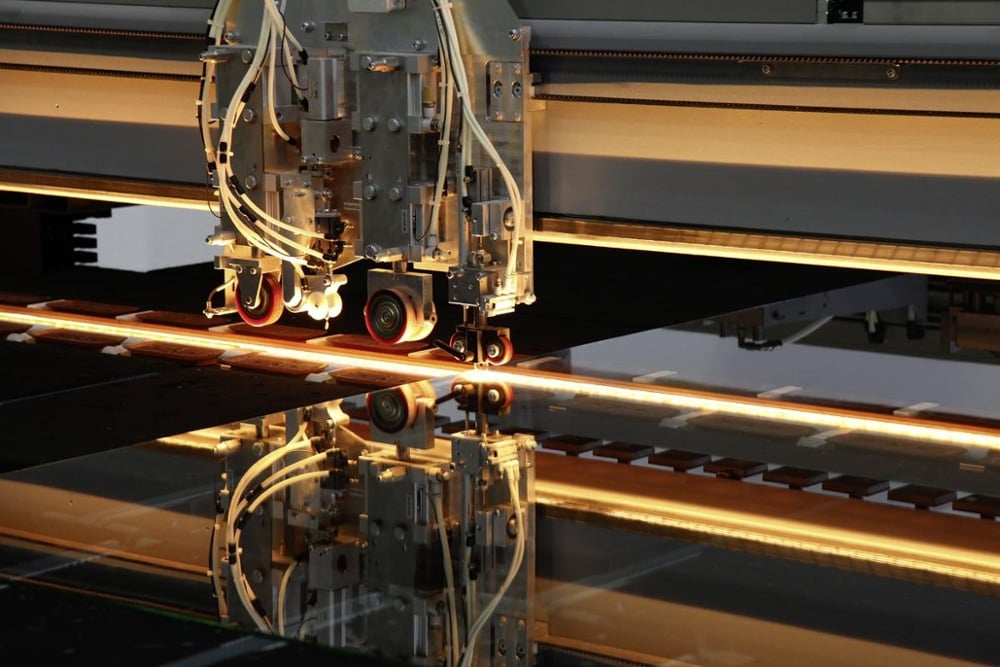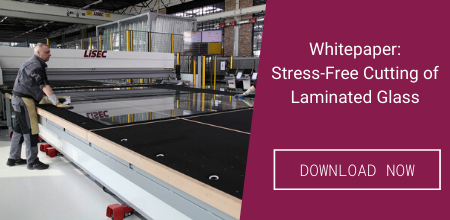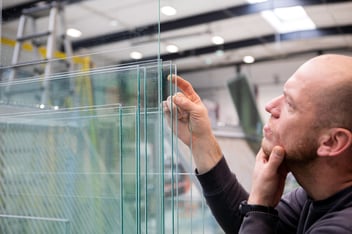Everyone who processes this material knows that laminated safety glass (LSG) is unconventional and requires a great deal of sensitivity. The LSG cracks and chips and finally the question arises: What was to blame for the breakage? Was the cutting pressure too low? Was the crushing pressure too high? Cutting speed, acceleration, crushing roller feed, cutting wheel angle, temperature, cutting oil or was it tension in the glass during production in the glassworks? The influencing factors are unmanageable and glass qualities fluctuate constantly.
In this blog article we shed light on the production influencing factor when cutting LSG. Further articles will deal with factors influencing the stock, machine settings and the design of the machine.
WHY LAMINATED SAFETY GLASS IS BECOMING INCREASINGLY IMPORTANT
The most important thing about laminated safety glass is how it behaves when broken. This means that the sheet does not collapse, as the glass/foil/glass laminate ensures residual load-bearing capacity through the interlayer (usually PVB foil).
This residual load-bearing capacity is particularly important for glass railings, stair railings or other vertically installed glass lites sheets.
In the event of glass breakage, it is guaranteed that the laminate retains its shape and, in the case of a railing, functions as a fall protection. This property is also a basic prerequisite for overhead glass installations in order to prevent injuries to persons due to glass breakage. The DIN 18008 standard also contributes to the fact that vertically installed flat glass sheets up to a certain height must exhibit safe breaking behaviour.
It is therefore hardly surprising that flat glass processing companies have to increase their processing capacities, especially for cutting lines for laminated safety glass, in order to be able to produce more sheets now and in the future.
WHAT INFLUENCE THE PRODUCTION OF LAMINATED SAFETY GLASS ALREADY HAS ON GLASS CUTTING
In order to show what influence the production already has on the later cutting of laminated safety glass, we start with the most important production steps.
1. FLOAT GLASS PRODUCTION
The basis for laminated safety glass is float glass. Float glass is produced in glassworks from molten glass, which flows out of the “float tank” via a tin bath and is then produced in corresponding thicknesses. Due to the tin bath it comes into contact with the underside of the float glass is also called the tin side.
The float glass upper side is called the air side because it comes into contact with air after the float tank. Both surfaces have different properties due to these facts. The tin bath influences the surface hardness of the later glass due to the fact that the tin side cools down more slowly and thus becomes softer. The air side cools faster but this leads to a harder surface.
These marginally different surface tensions cause distortions on the glass surface. This means that the surface is not 100% flat, but more or less wavy. Another fact is that the tin bath leaves metallic residues on the glass, which have negative effects in the subsequent coating process (application of metallic coatings - heat or
sun protection coatings).
2. COATING OF FLOAT GLASS WITH METALLIC COATINGS
Metallic coatings, also known as heat insulation coatings or low-E (low emission) coatings, are applied to the glass using the magnetron high-vacuum process. In a high vacuum, the glass sheet is exposed to a vapour stream of metallic particles and applied layer by layer.
A high-purity surface on which the coating is applied is the basic prerequisite for flawless optically appealing coatings. Coatings are therefore always applied to the air side, as this has a clean surface.
3. PRODUCTION OF LAMINATED SAFETY GLASS
The production of laminated glass consists of several work steps. The raw glasses
are first cleaned, then the lower sheet is positioned and the PVB foil is applied. Then the upper sheet is placed and the sandwich is complete. This sandwich is prepared in a pre-laminating process for the subsequent auto-claving process.
In the autoclave the sandwiches are finished under vacuum and heat. The air is extracted from the sandwich laminate, the PVB foil melts and combines with the glass to form a laminate.

4. UNCOATED LAMINATED GLASS
As already mentioned, the air side of a float glass is highly pure, while the tin side may contain impurities from the tin bath and has other different surface properties. For this reason, laminated safety glass is constructed in this way:
First sheet: Tin side at top, air side on inside
Foil
Second sheet: Air side at top, tin side on bottom
This constellation of the laminate guarantees excellent adhesion properties due to the situation, as both air sides are brought together. It is an advantage for processing that two sheets with similar tension properties are brought together. Such laminated safety glasses are generally less strained and allow relatively similar cutting pressures on the lower and upper sides, since the tin side is softer on the upper and lower sides than the air side.
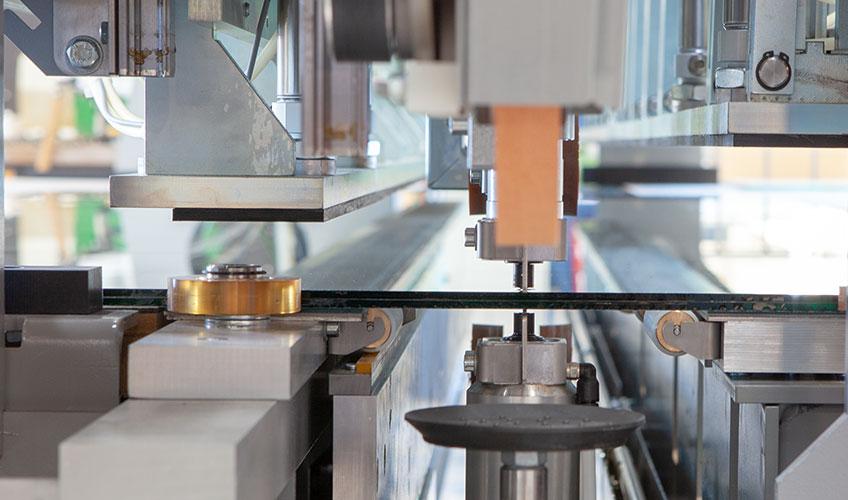
5. ATTENTION WITH COATED LAMINATED GLASS
Laminated glass for use on conventional buildings, such as single-family houses,
consists of two sheets of laminated glass connected by a PVB foil. Due to ever increasing demands on insulating glass and the use of triple insulating glass, the processed laminated glass is usually a laminate of a float glass sheet and a coated sheet.
Due to the fact that the coated side must not be laminated on the inside, a non-ideal constellation arises in production, which looks as follows:
First sheet: Air side at top with coating, tin side on inside
Foil
Second sheet: Air side at top, tin side on inside.
This unfavourable constellation leads to different surfaces and therefore also surface tensions being connected by the foil. Furthermore, coated glass lites sheets are usually produced at different locations than the float glass with which they are laminated and therefore have a different chemical property.
Thus the themes of different surface tensions, different origins and not ideal constellations come together. This usually results in the coated laminated glass being much more difficult to process and requiring more experience from the operator and higher demands on the machine used for processing.
CONCLUSION: CHALLENGES POSED BY PRODUCTION WHEN CUTTING LSG
Uncoated laminated safety glass is usually less strained due to the production process and can therefore be processed more easily. Coated laminated glass, on the other hand, has considerably higher stresses and therefore requires much more experience on the part of the processor. Of course, the right parameters and flexible machines also help. But more on this in one of the next articles. And if the tension is much too great, then of course all that the manufacturer will be left with is a complaint.







